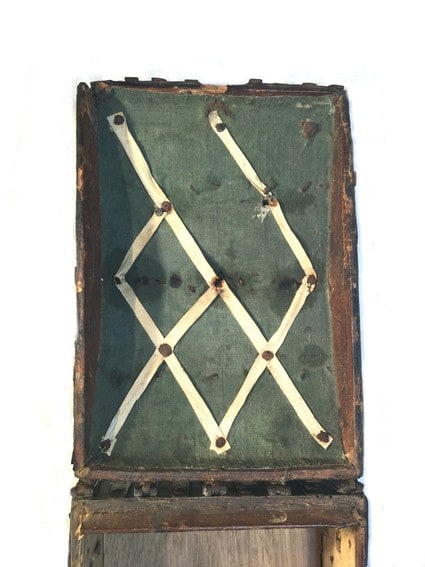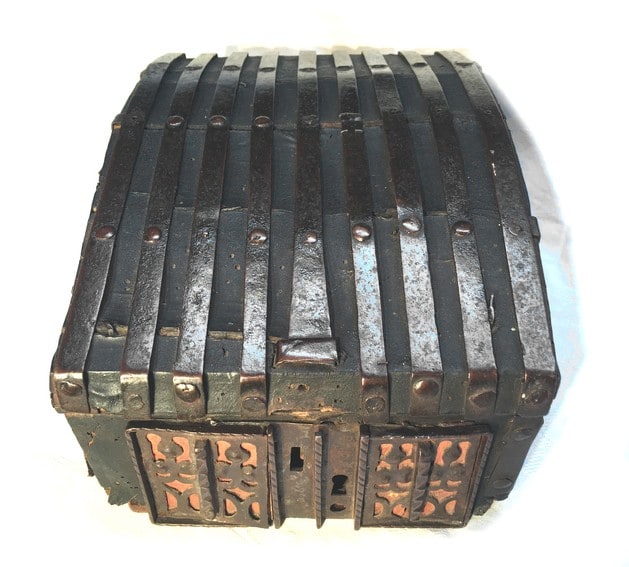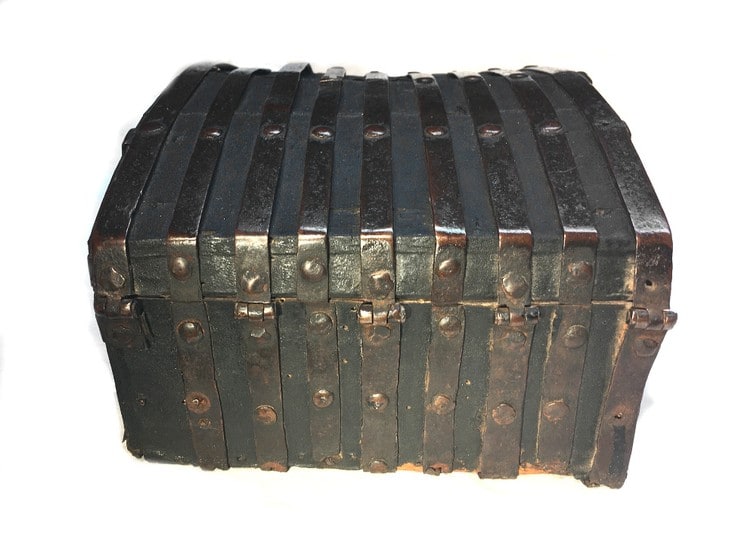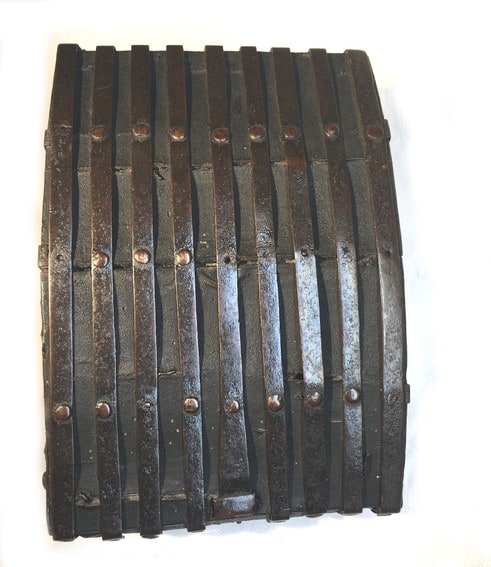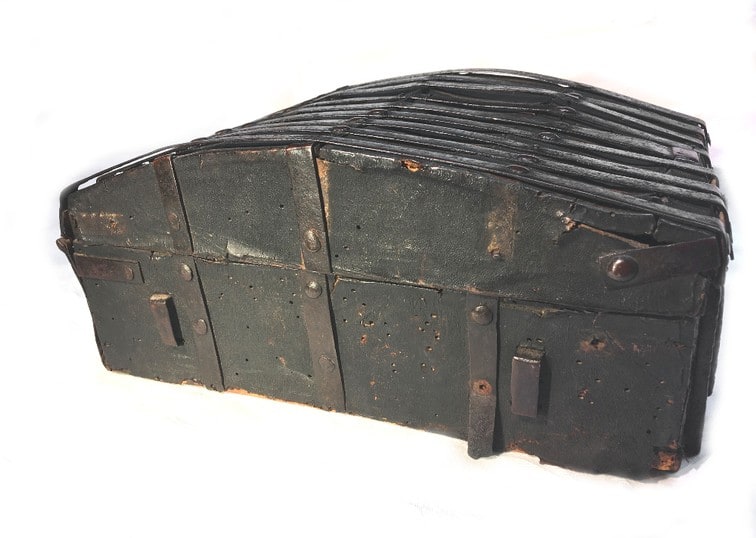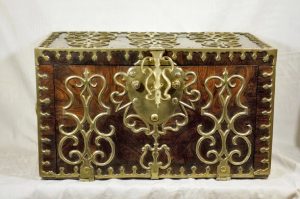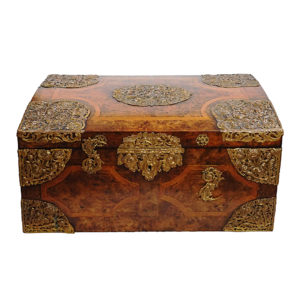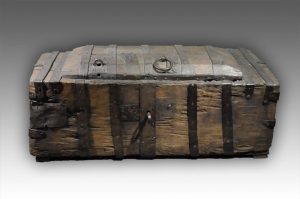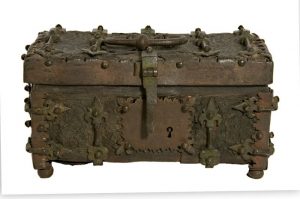- +49 (0) 30 882 16 21
- info@seidel-und-sohn.de
-
Mo - Fr: 11:00 - 18:00
Sa: 11:00 - 16:00
Warenkorb anzeigen „Lade einer Gilde – 3. Drittel 17. Jahrhundert – Anfang 18. Jahrhundert“ wurde Ihrem Warenkorb hinzugefügt.
Buch- bzw. Reisekästchen
Kategorie: Truhen & Kästen
Beschreibung:
Buch- bzw. Reisekästchen
Frankreich, um 1500
Höhe: 12,2 cm, Länge: 27,4 cm, Tiefe: 19 cm.
Buchkästchen, mit Leder bezogen, der gewölbte Deckel mit neun Eisenverstrebungen verstärkt, zwei Schlösser mit außenliegendem Mechanismus. An der Seiten mit Laschen. Kasten mit Wurmlöchern, ohne Überwurfbügel und Schlüssel.
Das Kästchen beinhaltete früher ein Holzschnittdruck, der die Bedeutung von Christus, die Christliche Passion und ihre Instrumente hervorhob.
Es sind ca. 140 gotische Kästchens bekannt, die meisten in europäischen Museen; ein paar von ihnen haben noch die Pferdehaarkissen auf der Unterseite und beinhalten Geheimfächer, was darauf schließen lässt, dass in den Kästchen einmal Gegenstände aufbewahrt und als Rucksack getragen wurden.
Ein kürzlich von Sandra Hindman entdecktes nordisches Renaissancegemälde „Rast auf der Flucht“, führt zu einer Neubetrachtung dieser Kästchen als Reisekästchen. Das Gemälde, gemalt in Antwerpen ca. 1530, in der Tradition von Joachim Patinir, zeigt Details eines teilweise offenen Kästchens. In dem Kästchen kann man ein kleines, in Leder gebundenes Buch mit Schließen, ein Rosenkranz aus wertvollen Steinen, eine Bürste, Schere und zwei Fingerringe erkennen, alles auf transparentem weißen Stoff im Kästchen drapiert. Dies ist die einzige bekannte zeitgenössische Darstellung eines dieser gotischen Kästchens.
Literatur:
The Bodleian’s incredibly rare medieval book coffer, Bodleian Libraries at the Univesitiy of Oxford, United Kingdom.
Zum Vergleich:
Les Enluminures, Sandra Hindman, Gothic Traveling Coffers
A coffer
France, about 1500.
Height: 12,2 cm, Lenght: 27,4 cm, width: 19 cm.
A wooden box with leather, the domed cover reinforced with 9 iron fittings, and a lock with exposed mechanism, the print lacking.
Approximately 140 Gothic Coffers and fugitive prints survive (around 110 Coffers and 30 prints), most in European museums. A few preserve their secret compartments or their horsehair cushions, evidence that they once contained objects and were carried as backpacks. All include rare hand-colored prints, some unique, others surviving in only a few impressions. Most of the prints are related to the Parisian workshop of the Master of the Très Petites Heures of Anne de Bretagne (now identified as the artist Jean d’Ypres). Any study of the origins of French print-making must take into account these Coffers and their remarkable prints. The body of material is exceptional, for the viewing context helps explain the function of the prints. Further investigation of these practical, accessible, and intriguing objects promises new insights into the relationship between devotional imagery and visual culture in Early Modern France.
The recent discovery of a Northern Renaissance painting of the Rest on the Flight, published by Sandra Hindman, prompts a reconsideration of the Coffers with prints as traveling boxes. Painted in Antwerp c. 1530 by an artist working in the tradition of Joachim Patinir, the painting includes a detail of a large, partially opened box. A small leather-bound book with clasps, a rosary composed of precious gems, a brush, scissors, and two finger-rings all nest on a bunch of diaphanous white cloth inside the box. This detail survives as the only known contemporary depiction of these Gothic Coffers.
Ähnliche Objekte
-
Truhen & Kästen
Lade einer Gilde – 3. Drittel 17. Jahrhundert – Anfang 18. Jahrhundert
€ 17.500,00 In den Warenkorb



